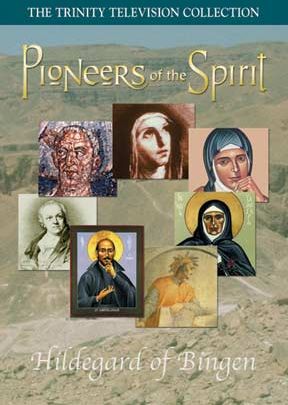Hildegard of Bingen: Sybil of the Rhine
CONTEMPORARIES called Hildegard of Bingen the “Sybil of the Rhine.” (The Rhine is a river flowing through Germany; “sibyls” were ancient Greek female prophets whose prophecies came in visions.) At five years of age, she began to see visions. At eight she joined her Aunt Jutta, an anchoress who was walled away from the world in a cell attached to a church. Jutta gave her a rudimentary education. Hildegard became a nun at fourteen, and, in due course, she became the abbess of a Benedictine convent.
None of these experiences were unusual in the twelfth century. What was unusual was the way in which Hildegard mastered the religious and scientific lore of her time and became a leading voice of her age. Out of a sense of inferiority or humility, she did not begin writing until she was forty-two, saying then that God ordered her to do so.
Once she began writing, however, she was prolific. She produced an encyclopedia of science and medicine. It was based on the scientific theories and legends of the day, but it incorporated many original observations. She also wrote biographies of saints. As an artist, she made twenty-six colorful illustrations in which she tried to capture her visions. As if that was not enough, she composed music that has been revived in the twentieth century. She wrote the first known morality play and a song cycle that has this to say of Christ:
Set us upright Savior, Christ....
O most beautiful form!
O most sweet savor of desirable delight!
We ever sigh after you in fearful exile,
when will we see you and dwell with you?
Among her works were hundreds of letters advising and rebuking her contemporaries—many of whom considered her a prophet. Among their recipients was Bernard of Clairvaux, one of her admirers.
Hildegard’s drawings and her descriptions of her visions have led doctors to conjecture that she may have suffered from migraines with their accompanying auras. These can fill the field of vision with shimmering lines of light and bright spots, and can be accompanied by a strong sense of certainty or doubt.
As Hildegard grew older, she became more venturesome. At sixty, she undertook preaching tours, calling for the cleansing of the church. She scolded “lukewarm and sluggish” churchmen, and those who neglected scripture. A few paragraphs of her prophecies seem to foretell the Reformation, although the papacy never fell into as deep a decline as she predicted.
The Sybil of the Rhine died on this day, 17 September 1179. After centuries of neglect, the feminist movement of the twentieth century rediscovered her, and continues to promote her original contributions to theology, music, and art.*
—Dan Graves
----------
Several of Hildegard's musical compositions can be downloaded from archive.org
For more about her, consult these videos: Hildegard at RedeemTV
(Hildegard can be purchased at Vision Video)
and Pioneers Of The Spirit: Hildegard Of Bingen can be purchased at Vision Video.
She is quoted in "All life has its roots in me" in Christian History #119, The Wonder of Creation









